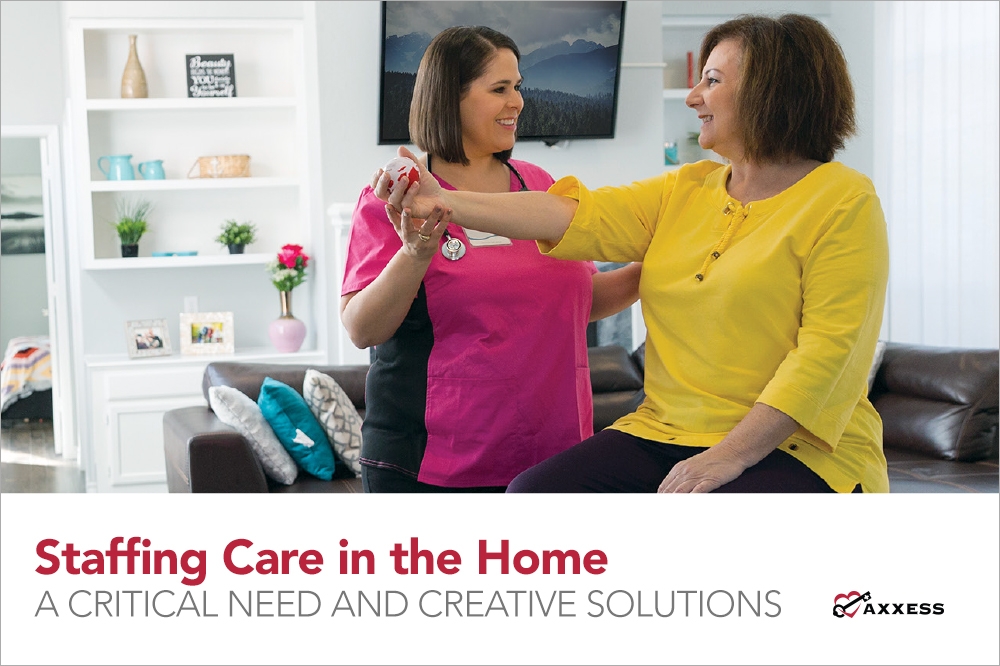Each day more and more baby boomers reach the age where they either leave the workforce or require care in their home. Sometimes, both of those things happen at the same time, and that puts pressure on healthcare providers. Research from the Health Resources and Services Administration shows that the demand for nurses will grow 46 percent by 2030. The Census Bureau also estimates that by 2030 some 76 million people will be older than age 65, which will account for one in five people in the United States.
This trend has led to a crisis across the industry that is putting a strain on agencies struggling to find nurses, and on nurses struggling to care for a rising number of patients. Axxess has gathered available information on staffing issues and put together “Staffing Care in the Home: A Critical Need and Creative Solutions.” This white paper examines the issues creating the shortages and showcases solutions that are working across the healthcare industry.
The Cost of Turnover
Agencies that cannot retain employees are dealing with a significant drain on financial resources. A survey of agencies in Wisconsin reported in Bloomberg Businessweek, for instance, found that 85 percent of respondents indicated they did not have the staff necessary to cover the number of shifts that had been scheduled. Nurses, aides, and personal caregivers are often forced to pick up extra shifts while managers recruit new personnel. This resulting strain can negatively impact employee morale and lead to even more turnover. Experts in staffing have estimated that replacing an employee can cost an organization between 150 and 250 percent of that employee’s salary.
Pay Issues Affecting Recruitment and Retention
Attracting and retaining new employees can be challenging for those providing care in the home because aides and personal caregivers are often on the low end of the pay scale. The Bureau of Labor Statistics puts the average salary of a home health aide at just $22,200. The possibility that low-wage workers would jump to another agency for an increase in pay is not only real, they are looking to other industries as well. A survey by myCNAjobs.com found that these workers are willing to jump to other industries like retail and fast food for the opportunity to make more money.
Innovative Attempts to Meet the Challenge
There are several different approaches working in the healthcare industry to help organizations overcome a staffing shortage. The most common solution either recommended or implemented has focused on the infusion of younger people entering the workforce.
A study published in Health Affairs found that millennials are 186 percent more likely to become a registered nurse than a baby boomer was in their 20s and 30s. Eric Scharber with Exact Recruiting shared four examples that organizations can use to appeal to millennials:
- Pay a fair rate of compensation and be competitive.
- Be engaged with the recruit.
- Make sure they are not in a dead-end job.
- Make sure to have robust continuing education programs.
Technology is another staffing solution that can appeal to people of all ages because of its ability to provide convenience. Axxess created a free software solution for users of Axxess software that connects agencies with qualified clinicians to provide timely care for for patients. AxxessCARE is in the pilot phase in Texas but will eventually be rolled out nationwide.
Clinicians who sign up for AxxessCARE and complete background and certification checks can search for available visits posted by agencies in a desired area. When a clinician applies for a visit, an agency can then see their qualifications and rating and choose to assign who they deem to be the most qualified caregiver for the patient.
The staffing shortage is a complex problem without easy answers that requires an in-depth understanding of the issues creating challenges for agencies. Axxess has examined the challenges and laid out several more innovative solutions in “Staffing Care in the Home: A Critical Need and Creative Solutions.” Download the white paper to learn more. It is our hope that these ideas provide valuable insights for possible solutions, and even inspire more ideas on how to address this longstanding challenge.

